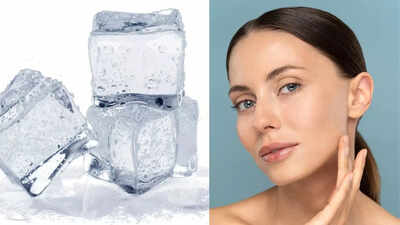Facial icing, also known as skin icing or cryotherapy, has surged in popularity on social media, lauded for its supposed therapeutic and aesthetic advantages. Proponents claim it can alleviate acne, reduce swollen eyes, and address other skin concerns.

While cold therapy is a recognized treatment for injuries and pain management, the scientific community remains skeptical about its specific benefits for facial skin. Despite the lack of definitive scientific validation, many individuals are convinced of its effectiveness, fueling its rise as a prominent beauty trend. Further research is necessary to substantiate its purported benefits for the skin.
According to Healthline, there are two common methods recommended by facial icing enthusiasts:
Regardless of the chosen method, gently massage your face in slow, circular motions for approximately 1 to 2 minutes. Exercise caution to prevent prolonged direct contact between the ice and your skin, as extended exposure may lead to irritation. This circular massage can be performed daily, targeting areas such as:
Before incorporating ice facials into your skincare regimen, seek personalized guidance from a healthcare or skincare professional. Consider these helpful tips:
Remember to frequently replace the ice and wrapping to minimize bacterial spread. Icing should complement, not replace, your established skincare routine.
Several factors contribute to the increasing popularity of ice facials:
According to Healthline, improper or extended facial icing can result in:
Individuals with pre-existing health conditions like diabetes or Raynaud's syndrome should exercise caution or consult a physician before trying facial icing, as it may exacerbate existing sensitivities or nerve issues.
Facial icing offers several potential benefits:
While these benefits appear promising, further research is warranted to validate the direct effects of facial icing on puffiness and acne.
Disclaimer: The content provided is for informational purposes only and does not substitute professional medical or dermatological advice. Individual skin types and conditions differ. Always consult with a dermatologist before implementing new skincare practices.
Newer articles
 Greg Chappell: Rishabh Pant is Revolutionizing Cricket with Unconventional Batting Style
Greg Chappell: Rishabh Pant is Revolutionizing Cricket with Unconventional Batting Style
 Earth's Spin Accelerates: Scientists Predict Possible Negative Leap Second by 2029
Earth's Spin Accelerates: Scientists Predict Possible Negative Leap Second by 2029
 Samsung Galaxy A35 5G and A55 5G: Official Pricing and Availability Announced
Samsung Galaxy A35 5G and A55 5G: Official Pricing and Availability Announced
 3 Secrets to a Longer, Healthier Life: Lessons From Japan's Longevity Village
3 Secrets to a Longer, Healthier Life: Lessons From Japan's Longevity Village
 Silent Signals: Heed These Early Heart Attack Warning Signs
Silent Signals: Heed These Early Heart Attack Warning Signs
 Prediabetes Warning: 5 Subtle Signs Your Body Could Be Signaling High Blood Sugar
Prediabetes Warning: 5 Subtle Signs Your Body Could Be Signaling High Blood Sugar
 Gujarat Cricket Association Set to Launch New T20 League, Aiming to Boost Local Talent
Gujarat Cricket Association Set to Launch New T20 League, Aiming to Boost Local Talent
 Raducanu Shuts Down Alcaraz Dating Rumors, Confirms US Open Mixed Doubles Pairing
Raducanu Shuts Down Alcaraz Dating Rumors, Confirms US Open Mixed Doubles Pairing
 'The Traitors' Star Apoorva Mukhija Accuses Sudhanshu Pandey of Misogyny and Abusive Language After On-Screen Criticism
'The Traitors' Star Apoorva Mukhija Accuses Sudhanshu Pandey of Misogyny and Abusive Language After On-Screen Criticism
 Prasidh Krishna Vows to Sharpen Bowling Accuracy and Cut Run Rate in Upcoming Tests
Alternatively (shorter):
Prasidh Krishna Targets Length Improvement, Lower Economy After Costly Outing
Prasidh Krishna Vows to Sharpen Bowling Accuracy and Cut Run Rate in Upcoming Tests
Alternatively (shorter):
Prasidh Krishna Targets Length Improvement, Lower Economy After Costly Outing